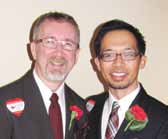 As of July 17, nearly 44 percent of the U.S. population lives in 19 states and the District of Columbia where same-sex couples legally may marry. One year ago—even after the 2012 election in which three states affirmed marriage equality at the ballot and after Minnesota’s legislature followed suit a few months later—just 18 percent, or less than one-fifth, of the U.S. population lived in marriage equality states. Even six months ago that number had risen to just 33 percent, or one-third of the population. We’ve made extremely rapid progress, and are within striking distance of a majority of the population having access to marriage equality where they live.
As of July 17, nearly 44 percent of the U.S. population lives in 19 states and the District of Columbia where same-sex couples legally may marry. One year ago—even after the 2012 election in which three states affirmed marriage equality at the ballot and after Minnesota’s legislature followed suit a few months later—just 18 percent, or less than one-fifth, of the U.S. population lived in marriage equality states. Even six months ago that number had risen to just 33 percent, or one-third of the population. We’ve made extremely rapid progress, and are within striking distance of a majority of the population having access to marriage equality where they live.
In a sense, we’ve already sped well past the halfway mark.
Thanks to the legal principles espoused by the U.S. Supreme Court in Windsor, every decision in every marriage case in state, district, and appellate courts since June 2013 has concluded that state marriage bans are unconstitutional. This includes a decision by the Tenth Circuit Court of Appeals in Kitchen v. Herbert, the case challenging Utah’s marriage ban; should this decision ultimately be upheld, it will mean that bans in the other Tenth Circuit states also will fall.
Unfortunately, in 13 of these states and within the Tenth Circuit, decisions striking down marriage bans have been stayed pending appeal. An additional 30 percent of the U.S. population lives in these 13 states. This means a total of 74 percent of the U.S. population, nearly three-quarters, lives in a state or territory where the freedom to marry has been affirmed in principle, if not yet in effect.
With lawsuits under way in every other state where marriage bans still exist, this percentage changes on practically a weekly basis. Just as I was getting ready to send this column to the publisher, in fact, a Florida judge ruled that state’s marriage ban unconstitutional. Assuming this ruling also is stayed pending appeal, this would bring the percentage of the population living in such states to 36 percent, for a total of 80 percent of the population residing in states or territories where marriage equality is active or has been affirmed but temporarily put on hold.
Moreover, now that we have a Circuit Court decision from the Tenth Circuit, with a second from that court and one from the Fourth Circuit expected any day now as well, there are cases knocking on the door of the U.S. Supreme Court. Many of us expect the Supreme Court to agree to hear one of these cases as soon as this fall or winter, which could result in a ruling by next June taking us from 44 percent marriage equality to 100 percent in one fell swoop. In the meantime, you can follow the progress of state marriage equality rulings and population percentages on the Marriage Equality USA map at http://www.marriageequality.org/national-map
Thom Watson, a leader in the nationwide grassroots organization Marriage Equality USA, lives in Daly City with his husband, Jeff Tabaco..
Recent Comments